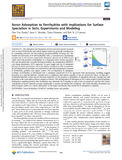Mostrar el registro sencillo del ítem
Boron adsorption to ferrihydrite with implications for surface speciation in soils: Experiments and modeling
| dc.creator | Van Eynde, Elise | |
| dc.creator | Méndez Fernández, Juan Carlos | |
| dc.creator | Hiemstra, Tjisse | |
| dc.creator | Comans, Rob N. J. | |
| dc.date.accessioned | 2021-06-24T15:35:22Z | |
| dc.date.available | 2021-06-24T15:35:22Z | |
| dc.date.issued | 2020-07-29 | |
| dc.identifier.citation | https://pubs.acs.org/doi/10.1021/acsearthspacechem.0c00078 | |
| dc.identifier.issn | 2472-3452 | |
| dc.identifier.uri | https://hdl.handle.net/10669/83783 | |
| dc.description.abstract | The adsorption and desorption of boric acid onto reactive materials such as metal (hydr)oxides and natural organic matter are generally considered to be controlling processes for the leaching and bioavailability of boron (B). We studied the interaction of B with ferrihydrite (Fh), a nanosized iron (hydr)oxide omnipresent in soil systems, using batch adsorption experiments at different pH values and in the presence of phosphate as a competing anion. Surface speciation of B was described with a recently developed multisite ion complexation (MUSIC) and charge distribution (CD) approach. To gain insight into the B adsorption behavior in whole-soil systems, and in the relative contribution of Fh in particular, the pH-dependent B speciation was evaluated for soils with representative amounts of ferrihydrite, goethite, and organic matter. The pH-dependent B adsorption envelope of ferrihydrite is bell-shaped with a maximum around pH 8–9. In agreement with spectroscopy, modeling suggests formation of a trigonal bidentate complex and an additional outer-sphere complex at low to neutral pH values. At high pH, a tetrahedral bidentate surface species becomes important. In the presence of phosphate, B adsorption decreases strongly and only formation of the outer-sphere surface complex is relevant. The pH-dependent B adsorption to Fh is rather similar to that of goethite. Multisurface modeling predicts that ferrihydrite may dominate the B binding in soils at low to neutral pH and that the relative contribution of humic material increases significantly at neutral and alkaline pH conditions. This study identifies ferrihydrite and natural organic matter (i.e., humic substances) as the major constituents that control the B adsorption in topsoils. | es_ES |
| dc.description.sponsorship | The Dutch Research Council/[Grant N°14688]/NWO/Países Bajos | es_ES |
| dc.language.iso | eng | es_ES |
| dc.source | ACS Earth and Space Chemistry, vo.4(8), pp.1269-1280 | es_ES |
| dc.subject | Boron | es_ES |
| dc.subject | Ferrihydrite | es_ES |
| dc.subject | CD-MUSIC modeling | es_ES |
| dc.subject | Humic acid | es_ES |
| dc.subject | Goethite | es_ES |
| dc.title | Boron adsorption to ferrihydrite with implications for surface speciation in soils: Experiments and modeling | es_ES |
| dc.type | artículo original | |
| dc.identifier.doi | 10.1021/acsearthspacechem.0c00078 | |
| dc.description.procedence | UCR::Vicerrectoría de Investigación::Unidades de Investigación::Ciencias Agroalimentarias::Centro de Investigaciones Agronómicas (CIA) | es_ES |
Ficheros en el ítem
Este ítem aparece en la(s) siguiente(s) colección(ones)
-
Química [360]


